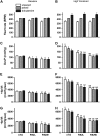R-92L and R-92W mutations in cardiac troponin T lead to distinct energetic phenotypes in intact mouse hearts
- PMID: 17526570
- PMCID: PMC1948064
- DOI: 10.1529/biophysj.107.107557
R-92L and R-92W mutations in cardiac troponin T lead to distinct energetic phenotypes in intact mouse hearts
Abstract
It is now known that the flexibility of the troponin T (TnT) tail determines thin filament conformation and hence cross-bridge cycling properties, expanding the classic structural role of TnT to a dynamic role regulating sarcomere function. Here, using transgenic mice bearing R-92W and R-92L missense mutations in cardiac TnT known to alter the flexibility of the TnT tropomyosin-binding domain, we found mutation-specific differences in the cost of contraction at the whole heart level. Compared to age- and gender-matched sibling hearts, mutant hearts demonstrate greater ATP utilization measured using (31)P NMR spectroscopy as decreases in [ATP] and [PCr] and |DeltaG(~ATP)| at all workloads and profound systolic and diastolic dysfunction at all energetic states. R-92W hearts showed more severe energetic abnormalities and greater contractile dysfunction than R-92L hearts. The cost of increasing contraction was abnormally high when [Ca(2+)] was used to increase work in mutant hearts but was normalized with supply of the beta-adrenergic agonist dobutamine. These results show that R-92L and R-92W mutations in the TM-binding domain of cardiac TnT alter thin filament structure and flexibility sufficiently to cause severe defects in both whole heart energetics and contractile performance, and that the magnitude of these changes is mutation specific.
Figures




References
-
- Maytum, R., M. A. Geeves, and S. S. Lehrer. 2002. A modulatory role for the troponin T tail domain in thin filament regulation. J. Biol. Chem. 277:29774–29780. - PubMed
-
- Tobacman, L. S., M. Nihli, C. Butters, M. Heller, V. Hatch, R. Craig, W. Lehman, and E. Homsher. 2002. The troponin tail domain promotes a conformational state of the thin filament that suppresses myosin activity. J. Biol. Chem. 277:27636–27642. - PubMed
-
- Tardiff, J. C. 2005. Sarcomeric proteins and familial hypertrophic cardiomyopathy: linking mutations in structural proteins to complex cardiovascular phenotypes. Heart Fail. Rev. 10:237–248. - PubMed
Publication types
MeSH terms
Substances
LinkOut - more resources
Full Text Sources
Other Literature Sources
Molecular Biology Databases
Miscellaneous

